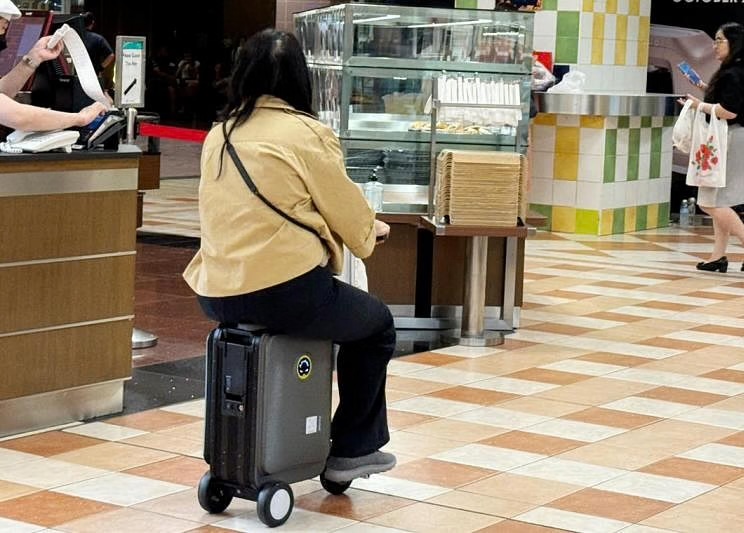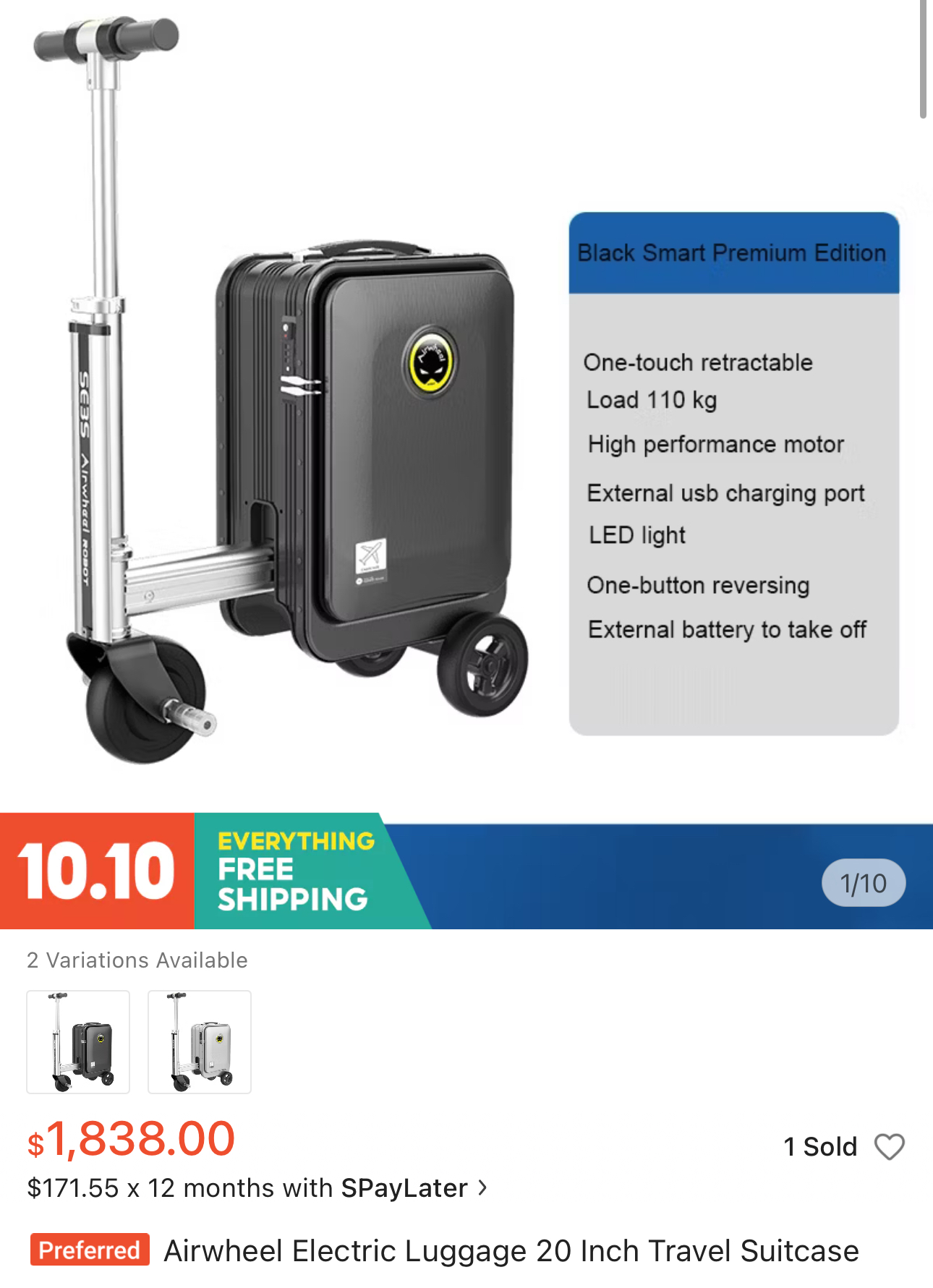Seen people riding on their luggage recently?

Regardless of whether you call it an “electric riding suitcase” or a “motorised luggage”, chances are you’ve probably seen it on social media, on the streets, or even in shopping malls.
But did you know that these electric riding suitcases are classified as Personal Mobility Devices (PMDs) in Singapore and have to be registered with the Land Transport Authority (LTA) for use? Even then, you can only ride these suitcases on cycling paths.
Here’s everything you need to know about these suitcases, and what you should do if you have one.
What is an Electric Riding Suitcase?
For those of us who haven’t heard of this new “PMD Final Boss”, here’s what an electric riding suitcase is.
It’s literally what its name suggests it is — an electrically powered suitcase which allows you to ride on it. Many of these suitcases can reach maximum speeds of up to 13 kilometres per hour.
You can think of the motorised suitcases a little like an electric scooter, except it comes in the form of a suitcase.
And you also don’t have “xi wang ni yi hou…” blasting on a speaker while riding the suitcase.

While these motorised suitcases have been around for years, it has seen a recent surge in popularity. For one, kids have been seen riding on these motorised suitcases in shopping malls such as Paragon Shopping Centre.

We’ve also seen TikToks of people using these motorised suitcases in Changi Airport.
Much like other PMDs, these suitcases aren’t cheap either — prices can go up to nearly $2,000. There’s always a price to pay for speed and convenience lah.
But at least no need to pay COE…

And if you’re wondering why you haven’t really seen these motorised suitcases being sold in-store in Singapore, well, it’s thanks to the price tag as well.
Concerns over high prices are a key reason why it’s rare to find motorised suitcases sold in Singapore. According to Lianhe Zaobao, several local suitcase retailers shared that they preferred not to sell motorised suitcases given the high prices and low demand.
Other retailers also shared that they were concerned about product quality and safety, as well as difficulties in finding repair centres for these suitcases.
Electric Riding Suitcases Cannot Be Ridden on Public Paths; Must Register With LTA to Ride on Cycling Paths
Even though more people have been spotted using these electric riding suitcases on public paths recently, it appears that they’re not supposed to unless they’ve registered their suitcases with the LTA.
But why is there a need to register a suitcase?
Well, as it turns out, these motorised suitcases are classified as PMDs. This means that unless your suitcase meets LTA’s device requirements and you register your suitcase with LTA, you can’t ride your motorised suitcases on public paths.
So, what are the requirements your motorised suitcase must meet? According to LTA, it has to have an unladen weight of not more than 20 kg, a maximum width of 70 cm, a maximum motorised device speed of 25 km/h, and certified to the UL2272 device safety standard.
If your motorised suitcase does not meet these standards, you don’t even have to think of registering your suitcase with the LTA. You cannot ride it anywhere on public paths — this includes cycling paths, roads, and footpaths. You’ll have to dismount and push the motorised suitcase whenever you’re on a public path.
Maybe can zoom around at home lah. Can ride your suitcase from your room to the kitchen.
If your motorised suitcase meets LTA’s requirements, you should register your suitcase with LTA. Once you register your suitcase with LTA, you can ride your motorised suitcase on cycling paths, but not on roads or footpaths.
Simple enough, right? Yet, according to Lianhe Zaobao, an LTA spokesperson shared that no one has currently registered their motorised suitcases with the LTA.
So, the next time you see someone zipping around on the street with a motorised suitcase, perhaps you should give them a friendly reminder to register their suitcase lah, hor?
Also, in case you’re wondering if you can ride a PMA in a mall, you might want to watch this to the end:
Electric Riding Suitcases Similarly Cannot Be Ridden in Changi Airport
Now, if you’re thinking: “I bought the suitcase to use in airport leh. Not public path, means no need to register, still can use right?”
Well, although LTA has left it up to Changi Airport to decide whether the use of electric riding suitcases is allowed within the airport, it turns out that Changi Airport prohibits the use of such electric riding suitcases as well.
In other words, registered or not, you cannot ride your motorised suitcases at Changi Airport lah.
According to Lianhe Zaobao, the Changi Airport Group stated that passengers are not allowed to ride motorised suitcases or PMDs within the airport for the safety of travellers and the public.
If travellers are found riding such motorised suitcases, they will be stopped to ensure the safety of themselves and others.
For those who already bought themselves a motorised suitcase after seeing it on TikTok, the only good news left is this — you can still use the motorised suitcase as a normal suitcase lah.
The Changi Airport Group added that these motorised suitcases can be treated as carry-on and check-in luggage, but must meet certain requirements such as having a removable battery.
Electric Riding Suitcases Prohibited in Tokyo’s Haneda Airport
Changi Airport is far from the first airport in the world to have prohibited these electric riding suitcases.
Earlier in February this year, Tokyo’s Haneda Airport banned the use of electric riding suitcases in airport terminals as well. The move was also a result of safety concerns, given the increased use of such suitcases in airports.
But that’s not all that Japan has done when it comes to cracking down on electric riding suitcases.
In Japan, these motorised suitcases can be classified as mopeds or smaller motorcycles. This means that those riding motorised suitcases must have a driving license to ride them on roads or motorways. If you’re spotted doing so without a driving license, you could be charged by the police.




